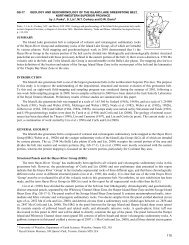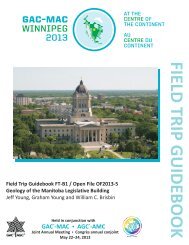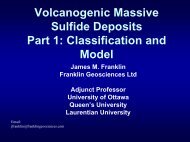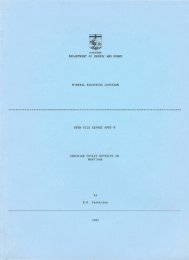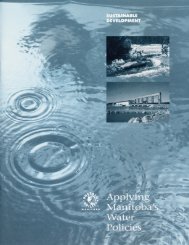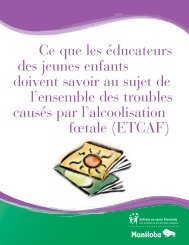Physical Volcanology, Hydrothermal Alteration and Massive ...
Physical Volcanology, Hydrothermal Alteration and Massive ...
Physical Volcanology, Hydrothermal Alteration and Massive ...
Create successful ePaper yourself
Turn your PDF publications into a flip-book with our unique Google optimized e-Paper software.
mosaics. The ash-size matrix is composed of interlocking mosaics of quartz <strong>and</strong> feldsparwith a wide variety of secondary alteration minerals. Locally these deposits are separatedby thin debris flow units <strong>and</strong> associated fine grained sedimentary rocks indicating that theeruptions were episodic.High Level Lake Succession (Units 3 <strong>and</strong> 4, Figs. 3 <strong>and</strong> 4)The High Level Lake Succession has been subdivided into two units: a)mesobreccia <strong>and</strong> b) quartz crystal-rich <strong>and</strong> pumice-rich pyroclastic flow deposits.Precaldera volcanic rocks <strong>and</strong> the Jackpot Lake pyroclastic units are immediately overlainby coarse heterolithic breccias that are interlayered with, <strong>and</strong> grade upwards into, quartzcrystal ash flow tuff deposits. The breccias have a strike length of at least 22 km <strong>and</strong>exhibit rapid changes in thickness from 80 to more than 900 m.The breccia deposits (Unit 3) are composed of block-<strong>and</strong> lapilli-size clasts of mafic<strong>and</strong> felsic volcanic rocks which are mineralogically <strong>and</strong> chemically similar to underlyingprecaldera <strong>and</strong> Jackpot Lake pyroclastic units. Recognizable clasts are poorly sorted <strong>and</strong>vary from measurable blocks 70 m by 40 m down to matrix-size material; typical size is 3to 25 cm. Detailed mapping <strong>and</strong> core logging also indicates that there are large blocks ofthe Darkwater scoria-tuff cone deposits that are more than 1 km in length <strong>and</strong> 300 m inthickness. Matrix material to the clasts varies from abundant alteration <strong>and</strong>metamorphosed alteration minerals (chloritoid, iron carbonate, <strong>and</strong>alusite, pyrophyllite,sericite, chlorite) to a composition very similar to the interlayered <strong>and</strong> overlying ash flowtuffs. Overall the composition of this unit is basaltic-<strong>and</strong>esitic. In the upper 5-50 m thebreccias contain sparse quartz crystals <strong>and</strong> lapilli-size pumice.These breccia deposits are similar to heterolithic breccias (mega- <strong>and</strong>mesobreccias) described by Lipman (1976, 1989) from calderas in the San JuanMountains. In the Sturgeon Lake Caldera Complex these coarse heterolithic breccias arebelieved to represent debris derived from caldera walls as collapse occurred; collapse <strong>and</strong>breccia formation were simultaneous with eruption <strong>and</strong> deposition of the High Level Lakequartz crystal ash flow tuff. Thick deposits of mesobreccia have been related tocatastrophic caldera subsidence of a kilometer or more (Lipman, 1976, 1989). Suchcatastrophic collapse in the Sturgeon Lake area could readily have moved the floor of the8



